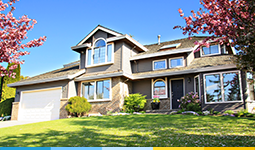Natural Disasters: Does Your Homeowners Insurance Cover You?
by Amy Lillard
(12/6/2012) “Superstorm” Sandy made big news in October when it slammed into the East Coast, leaving massive flooding due to storm surge and decimated neighborhoods . For those left to pick up the pieces, their home insurance has become a critical lifeline and key to rebuilding. But sadly, many of these homeowners are discovering that their insurance won’t cover all they need to rebuild and recover.
Sandy was highly notable in the extent of the storm and the damage it caused. But it’s critical for all homeowners to remember that natural disasters, including hurricanes, tornados, floods, wildfires, and earthquakes, can and do happen. And experts estimate that up to two-thirds of homeowners are not adequately insured to protect their homes and assets in.
Don’t fall prey to the “it won’t happen to me” assumption. With a few tips and suggestions, you can be better prepared for the unexpected.
Assess needs
What disasters are you at risk for? The answer may seem simple - folks in Southern California are probably more susceptible to earthquakes than tornadoes, while people living along the Gulf Coast are probably more concerned about hurricanes. But the fact is, natural disasters can and do happen in unexpected areas. Superstorm Sandy was a hurricane and massive flood that affected New York City, an area typically thought safe from such storms. Wilder, unpredictable weather in the last few years means that surprises can happen.
For a comprehensive assessment of what you could potentially face, you can contact your state insurance commissioner’s office, FEMA, or the National Flood Insurance Program (NFIP), which all have data and analysis around the history of disasters in various regions. This can provide insight into what you may realistically face living in a certain area.
Know your coverage
Start with this knowledge - most standard homeowner insurance policies specifically exclude natural disasters. Whether it’s hurricanes, earthquakes, wildfires, floods, or other disaster, most policies require a separate, additional rider for coverage. So it’s essential to know what coverage you have and what you don’t.
Floods deserve special mention here, as they can occur from multiple natural disasters, and are almost universally excluded from regular homeowners insurance. For protection from floods, homeowners need to apply for separate policies through the governmental entity NFIP. While the average policy costs about $600 a year, the return is significant — the average residential flood claim from 2007 to 2011 reached almost $30,000.
Consider costs
Once you’ve determined what natural disaster risks you face, and assessed your current coverage, it’s critical to look deeper. Considering how much damage a flood, tornado, hurricane or other natural disaster can cause, do you have enough in your coverage to provide all you need?
The worst case scenario is total loss, in which your home or building is destroyed or unusable after a storm passes. Your insurance should cover the cost of building a new home from scratch using comparable materials. In addition, it should cover the costs of living expenses in the interim, whether you’re living in temporary housing or another arrangement.
There are several things to pay attention to here:
• Replacement Cost — a policy for the replacement cost pays for the repair or replacement of damage property with comparable building materials.
• Extended Replacement Cost - this policy provides an additional cushion of 20 percent or more over the limits in your policy, which can offer support if an event pushes up the cost of building materials and labor.
• Inflation Guard - this coverage automatically adjusts the replacement costs of your home to reflect changes in construction costs.
• Ordinance or Law Coverage — this policy kicks in if you are required to rebuild your home to meet new (and often stricter) building codes.
In addition to replacing or repairing your home, you need to consider what’s in it. Does your coverage provide compensation for damaged or lost personal possessions? Most policies provide this type of coverage for approximately 50-70 percent of your total home insurance coverage: a $200,000 policy on the structure of the home would translate to a $100,000-140,000 coverage for your possessions within.
Think critically about whether this amount would cover your possessions. Organizations like the Insurance Information Institute offers home inventory worksheets or software to conduct a home inventory. With this completed, consider your coverage options:
• Cash Value Policy — this coverage pays to replace your belongings minus depreciation.
• Replacement Cost Policy — this goes further, reimbursing you for the full current cost of replacing your belongings. With this policy, the insurance company will pay to replace an old stereo with a comparable new one. A cash value policy will only pay the amount the stereo is worth.
Think ahead
Preparing for the possibility of a natural disaster is a worthwhile action, one that can pay off. To make sure you truly understand your risks, needs, and current coverage, and what you might need in the future, talk to an expert.
Working with an insurance agent does several things:
• Keeps you up-to-date. You can’t be expected to know everything about your home insurance and all the options available to you. Working with an agent can keep you up-to-date on new developments, things to consider, and ways to truly prepare yourself. In addition, by having a relationship with an agent, you can continually update your policy to reflect any home additions or life changes, which may save you money in the short or long term.
• Puts you at the front of the line. After a disaster happens, insurance companies are inundated with requests and claim applications. If you have a standing relationship with an agent, you may get your calls answered quicker, and will have help ensuring that your claims applications are as complete and prepared for success as possible.
• Answers all your tough questions. How do deductibles work? What about coverage for special items like jewelry, furs, or musical instruments? How does flood insurance really work? An expert in your corner means you can actually understand your insurance.
A final thought
No one wants to think that natural disasters could damage or destroy the home you’ve worked hard for. But doing just a few things to prepare yourself just in case can mean less stress, pain and cost if it does happen. Having conversations with your insurance company about your risks, needs and coverage are powerful steps to take. You can also do a few other smart things:
• Keep an inventory of your belongings, and keep it in several locations.
• Keep your insurance information handy, electronic, and in several places.
• Have a plan for your family, including where to meet in case of separation and emergency contacts and processes.
For more information, visit www.ready.gov for extensive details on planning for disasters.
Other related articles:
Natural Disasters: Making Effective Home Insurance Claims for Recovery
Federal agencies, lenders expand mortgage relief to borrowers affected by recent disasters
Home Insurance: How are Insurance Quotes Determined?
Homeowners Insurance: Filing a Claim
Home Insurance Costs on the Rise, Coverage Options Decrease
Home Insurance Quotes: Types of Home Owners Insurance
Fannie Mae & Jumbo Mortgage Rates
Just One Click! = Current Rate Chart

Start by selecting your state
Refinancing: Selecting a Loan

- Mortgage Program Options
- Interest Only Mortgage
- 100% Mortgage Financing - No Down Payment
- Mortgage Rates Comparison
- Search for Mortgage Rates
- No Costs Mortgage Refinancing
- 2% Rule - Refinancing Mortgage
- Yield Spread Premium
- Prepayment Penalty - Mortgage Refinancing
- What is APR and how is it calculated?
- Private Mortgage Insurance - Refinancing
Moving Ahead With Your Refinance
Get the Updated and Improved Mortgage Rates App from ERATE.com
FREE Mortgage Rate WidgetsYour State's Rates or National Rates Get this Widget for any State you want


